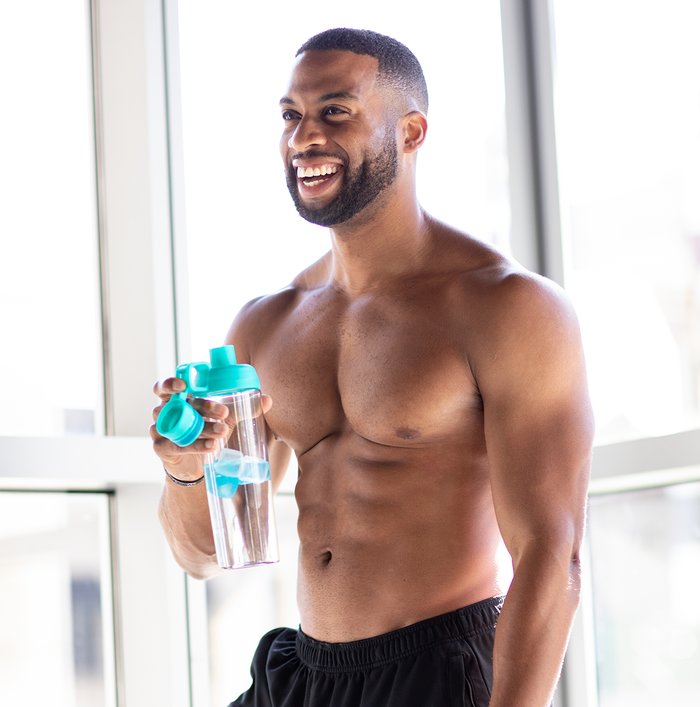Exercise hurts! Your muscles, your lungs, and your heart all take a beating when you put your body though a grueling workout. If you've ever done a really tough leg workout, you know what I'm talking about.
To make things worse, you can't really escape the pain after your workout. A day or two later, and those squats will come back to haunt you. Think you can walk up the stairs or sit on the toilet? Think again!
The recovery process can take a long time, and sometimes hurts so bad you can't even think about going to the gym the next day, let alone ride your mountain bike, hike, hit the lake, or shred the slopes. However, there are things you can do before, during, and after your workout to speed up the recovery process and make it a little less painful.
Utilize these seven recovery rules to bounce back to active living and training like a champ. If your game is on point, you may be able to hit your legs twice per week instead of taking a full seven days between workouts!
Quick-Recovery Rule 1: Prepare for War
Stretching may feel great, but it won't prevent the pain and stiffness you feel a day or two after a workout. What will help, however, is priming your body before you hit it hard. A study out of Australia found that performing a 10-minute warm-up before a workout decreased perceived soreness two days later.[1]

To prep your body for a tough workout, do low-intensity activity before you start your first set. Jog on the treadmill, crank out a few sets of bodyweight exercises, or, if you live close enough, walk to the gym instead of driving. A good warm-up adds just 10 minutes to your workout and will pay off big-time when you're more comfortable the next day.
If you're going to lift extremely heavy on specific movements, it also pays to warm up with a lighter weight on those exercises. Work your joints through a full range of motion, get some blood flowing, and make sure your body and mind are ready to work before you load a barbell with heavy iron.
Quick-Recovery Rule 2: Drink Up
An hour on the treadmill doesn't just bore you to tears, it also sucks a lot of water out of your body—if that puddle beneath you wasn't evidence enough. Dehydration can cause symptoms like fatigue, headaches, and dizziness. Research shows that dehydration also increases symptoms of delayed-onset muscle soreness (DOMS).[2] So, to speed up your recovery, drink!

Your hydration plan should be twofold: First, sip water throughout your sweat session. Second, down another beverage post-workout. If you'd like to try something other than water or BCAAs for your post-workout drink, consider cherry juice.
Compounds in tart cherries may decrease the inflammation that results from muscle damage, which can help muscles repair faster and even reduce exercise-induced pain.[3-5]
Quick-Recovery Rule 3: Get A Rubdown
If there's ever a time to treat yourself to a massage, it's after a tough training cycle. A rubdown can reduce feelings of DOMS by a whopping 30 percent, according to a 2005 study.6
"Soft-tissue work helps increase blood flow and reduce the inflammatory process present in your blood after strenuous exercise," explains Jill Miller, author of "The Roll Model: A Step-by-Step Guide to Erase Pain, Improve Mobility, and Live Better in Your Body."
"Applying pressure also eases fascial and muscular stiffness that often results from overtraining," she adds.

If professional massages aren't in your budget, self-myofascial release (SMR) is a cheaper and equally effective alternative. The technique involves using a firm object such as a foam roller or rubber ball to apply pressure to muscles and connective tissue. Select a muscle group and place the roller or ball beneath it. Slowly roll a few inches, stop in a tender area, hold for a few seconds, then repeat in another spot.
Before your workout, Miller suggests performing SMR on the muscles you plan to target for five minutes before you lift. "After your workout, spend 5-10 minutes massaging the tissues you trained the hardest," says Miller. "Move slowly and breathe deeply, allowing yourself to unwind."
Quick-Recovery Rule 4: Put Your Muscles On Ice
There's a reason NFL locker rooms have ice tubs: Exposure to cold temperatures causes blood vessels to constrict, resulting in a reduction of swelling and inflammation.

A study published in the Journal of Science and Medicine in Sport found that cold-water immersion for 15 minutes following exhaustive exercise resulted in significantly lower muscle-soreness ratings and speedier recovery.[7]
If your gym has an icy plunge pool, take a 10-15 minute dip after your workout. Or, you can fill your home bathtub with cold water and ice. Be warned: This won't be enjoyable. It's also OK—and more bearable—to just submerge your legs or put in one arm at a time.
Quick-Recovery Rule 5: Eat!
"The smartest thing someone can do after a workout is eat something with a mix of protein and carbs," says Michele Lovitt, a Los Angeles-based exercise physiologist. "It helps reduce cortisol levels fast."
Consistently elevated levels of cortisol—a hormone released in response to stress and low levels of blood glucose—can eventually lead to the breakdown of muscle.

After your workout, eat or drink something that contains up to one gram of carbs per pound of body weight (if your goal is primarily performance) and 0.2-0.4 grams of protein per pound of body weight.
It's also wise to eat a protein-rich snack before bed. A study published in Medicine & Science in Sports and Exercise found that ingesting a beverage containing casein protein just before you sleep increases your rate of protein synthesis and circulating amino acids overnight.[8] That means gains!
Quick-Recovery Rule 6: Snooze Away
During the hours you sleep, the levels of growth hormone in your body are at their highest. Put this hormone increase together with your snoozing body working hard to repair damaged tissue, and you pretty much get to grow in your sleep!

If you don't prioritize catching z's, everything from your performance to your mood can suffer, which may ruin your next workout and totally kill your gains. Try to get 7-9 hours of shut-eye per night. If you've just finished a particularly grueling session, try to hit the higher end of that range.
To make getting to sleep and staying asleep easier, invest in a good mattress and buy quality pillows and sheets. To increase recovery, you may also try sleeping in compression tights. Research suggests wearing muscle-hugging garments during the 24 hours following a heavy resistance-training workout significantly boosts psychological and physiological markers of recovery.[9]
Quick-Recovery Rule 7: Keep Moving
When you can barely walk upstairs without cringing, the last thing you probably feel like doing is riding a bike, but do it anyway. Research shows that performing light exercise immediately after a tough workout temporarily alleviates symptoms of delayed-onset muscle soreness and may aid the removal of lactate from muscles.[10]

"By promoting circulation, active recovery can help reduce muscle stiffness and soreness, and restore laxity to the connective tissue," says Jacqueline Crockford, MS, CSCS.
So, walk, do yoga, or go for a bike ride on your off days! You'll recover faster and get back to the activities—and iron—you love.
References
- Law, R. Y., & Herbert, R. D. (2007). Warm-up reduces delayed-onset muscle soreness but cool-down does not: a randomised controlled trial. Australian Journal of Physiotherapy, 53(2), 91-95.
- Cleary, M. A., Sweeney, L. A., Kendrick, Z. V., & Sitler, M. R. (2005). Dehydration and symptoms of delayed-onset muscle soreness in hyperthermic males. Journal of Athletic Training, 40(4), 288.
- Wang, H., Nair, M. G., Strasburg, G. M., Chang, Y. C., Booren, A. M., Gray, J. I., & DeWitt, D. L. (1999). Antioxidant and antiinflammatory activities of anthocyanins and their aglycon, cyanidin, from tart cherries. Journal of Natural Products, 62(2), 294-296.
- Keuhl, K., & Perrier, E. (2010). Efficacy of Tart Cherry Juice in Reducing Muscle Pain During Running. Journal of the International Society of Sports Nutrition, 7, 17.
- Connolly, D. A. J., McHugh, M. P., & Padilla-Zakour, O. I. (2006). Efficacy of a tart cherry juice blend in preventing the symptoms of muscle damage. British Journal of Sports Medicine, 40(8), 679-683.
- Zainuddin, Z., Newton, M., Sacco, P., & Nosaka, K. (2005). Effects of massage on delayed-onset muscle soreness, swelling, and recovery of muscle function. Journal of Athletic Training, 40(3), 174.
- Ingram, J., Dawson, B., Goodman, C., Wallman, K., & Beilby, J. (2009). Effect of water immersion methods on post-exercise recovery from simulated team sport exercise. Journal of Science and Medicine in Sport, 12(3), 417-421.
- Groen, B., Pennings, B. A. R. T., Beelen, M., Wallis, G. A., Gijsen, A. P., Senden, J. M., & Van Loon, L. J. (2012). Protein ingestion before sleep improves postexercise overnight recovery. Medicine and Science in Sports and Exercise, 44(8), 1560-1569.
- Kraemer, W. J., Flanagan, S. D., Comstock, B. A., Fragala, M. S., Earp, J. E., Dunn-Lewis, C., ... & Maresh, C. M. (2010). Effects of a whole body compression garment on markers of recovery after a heavy resistance workout in men and women. The Journal of Strength & Conditioning Research, 24(3), 804-814.
- Monedero, J., & Donne, B. (2000). Effect of recovery interventions on lactate removal and subsequent performance. International Journal of Sports Medicine,21(8), 593-597.

